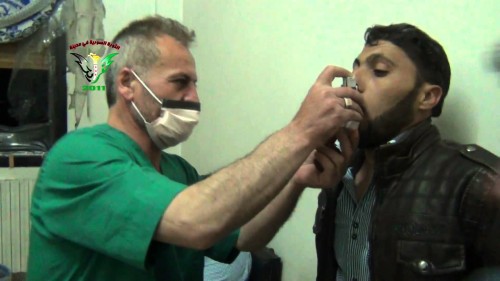PHOTO: Doctor with victim of last week’s alleged chemical weapons attack by Syrian regime in Kafrzita
In a propaganda move echoing the attempt to shift blame from the Assad regime for last August’s mass killing with chemical weapons, Iranian media is accusing insurgents of using “poison gas” near Homs.
Videos and eyewitnesses indicate that Syrian troops attacked Kafrzita in Hama Province last week with chlorine gas canisters inside barrel bombs, killing at least three people and wounding 200. There have been accusations of several chemical assaults near Damascus and on another town in Hama Province in the last three weeks.
Fars News, the outlet of Iran’s Revolutionary Guards, responds this morning with the declaration:
Foreign-backed militants fired mortar shells, containing poisonous chemical substances, on several residential areas in the city of Homs.
The terrorists attacked the cities of Al-Sabil and Al-Zahra districts in Homs with mortar rounds containing poisonous chlorine agent.
Chlorine gas, which was widely used during World War I, can be deadly.
Fars offers no evidence for the claim. Indeed, not even Syrian State media have alleged the use of chlorine — State news agency SANA says only, “6 citizens were killed and 40 others got injured as terrorists fired rocket and mortar shells”.
Instead, the Iranian outlet immediately shifts into the long-running campaign to blame insurgents for the deaths of hundreds of civilians in last summer’s attacks near Damascus:
In late August 2013, rebels and local residents in Ghouta in Damascus countryside accused Saudi Prince Bandar bin Sultan of providing chemical weapons to an al-Qaeda linked rebel group.
Interviews with people in Damascus and Ghouta, a suburb of the Syrian capital, where the humanitarian agency Doctors Without Borders said at least 355 people had died in late August from what it believed to be a neurotoxic agent, appear to indicate as much, Infowars.com said in a report written by Dale Gavlak and Yahya Ababneh.
From numerous interviews with doctors, Ghouta residents, rebel fighters and their families, a different picture emerges. Many believe that certain rebels received chemical weapons via the Saudi intelligence chief, Prince Bandar bin Sultan, and were responsible for carrying out the dealing gas attack.
Soon after the August attacks, Russian and Iranian agencies launched a campaign to disrupt the evidence pointing to the Syrian regime’s responsibility and construct a narrative shifting blame to insurgents.
See Russia Analysis: Diplomacy, Delay & Disinformation — How Moscow Gained The Upper Hand In Syria
Despite the clumsy presentation in outlets like Fars, the effort has had some success, with prominent Western journalists joining the conspiracy theories alleging Saudi or Turkish co-ordination of the attacks with the Syrian opposition.
See Syria Special: Dissecting Hersh’s “Insurgents Did Chemical Weapons Attacks” — A Sequel

